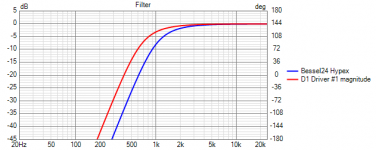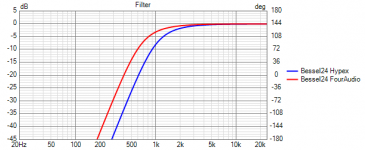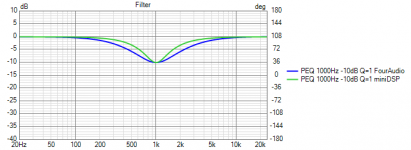Could have meant what the DSP option in VituixCad supports but obviously what Hypex supports.What else could I have meant?
Got it! This is exactly what I needed to know, thanks.Resistors, capacitors, inductors are passive components.
The common stuff I get, its the real basics such as finding a button or something that usually gets me. This is where I am and should be able to connect the dots with active components but only with drivers that have FRD and ZMA files.Are you sure this is where you want to start? Perhaps some basic electricity and filter theory might be a better starting point.
I've understood the general concepts of biqauds on my DSP system. I need some basic instructions to guide me on the general concept on how to export the biquads into the Hypex Design filter, not sure if there is an automatic way or its done manually. I am sure trial and error would be the best option. I read the manual, it helps a a lot but still can't manage to find how to import them into the Hypex design filter. I'll search a little harder in this forum.I would start by learning your DSP system, it sounds like you have much to learn before starting any work with VituixCAD.
Thanks.
Unfortunately, yes. To many concepts to comprehend.You are really jumping in the deep end of a fairly complex program.
I've read the manual, it gives you a great overview but sometimes you need simple instructions on basic things that are not in there.Have you downloaded Kimmo's VituixCAD User Manual?
I think I will chip away at it slowly as well. So far I got the jist of it and should manage a crossover with biquads but thats about it. I can measure on axis but don't know how to import measuremnts or combine near and far field etc but there all in the insturctions and forums so I can get to that as well. For now, I just want to understand the basic of designing a crossover and transfering into the Hypex design filter.It's very useful for beginners like you and me.
There's a lot in it, but it's set out logically. i.e. start at General Information, then work your way through to Checklist for Designing a Loudspeaker.
Once you have grasped that, then I found the best way was to experiment with Kimmo's demo files, continuing to read the manual as you go.
Then maybe start your project with all your own data and begin playing with it, referring to Kimmo's manual regarding the part you are working on - biquad, etc.
BTW, I am struggling to just do a simple passive design for a two way speaker. But every day I learn a bit more.👍
Thanks for your moral support.
As I said - I learn a little more each day.Unfortunately, yes. To many concepts to comprehend.
I've read the manual, it gives you a great overview but sometimes you need simple instructions on basic things that are not in there.
I think I will chip away at it slowly as well. So far I got the jist of it and should manage a crossover with biquads but thats about it. I can measure on axis but don't know how to import measuremnts or combine near and far field etc but there all in the insturctions and forums so I can get to that as well. For now, I just want to understand the basic of designing a crossover and transfering into the Hypex design filter.
Thanks for your moral support.
It's just a matter of persisting with reading Kimmo's Manual, practicing on your project or one of his demos, and asking questions here.
But make sure you try to understand the specific part of the Manual first, before you ask.
Also Google is your friend.
Generic active blocks which are found in Hypex HFD are needed / can be used. Should be these 13, including gain and delay setting with Buffer block:

Hypex has proprietary/secret coefficient calculation and VituixCAD cannot emulate it's frequency responses exactly correct so response calculation is done with 192k. Therefore also Copy biquad coefficients -command in popup menu would calculate wrong parameters for 48k.
BiQ block might be usefull for some special cases and when filter designer of the DSP gear/app accepts raw coefficients. That kind of apps are for example miniDSP with Advanced window and Analog Devices Sigma Studio (and dsp systems using Sigma Studio for EQ settings).
Hypex has proprietary/secret coefficient calculation and VituixCAD cannot emulate it's frequency responses exactly correct so response calculation is done with 192k. Therefore also Copy biquad coefficients -command in popup menu would calculate wrong parameters for 48k.
BiQ block might be usefull for some special cases and when filter designer of the DSP gear/app accepts raw coefficients. That kind of apps are for example miniDSP with Advanced window and Analog Devices Sigma Studio (and dsp systems using Sigma Studio for EQ settings).
Last edited:
Thanks for the information, helps a lot.Generic active blocks which are found in Hypex HFD are needed / can be used. Should be these 13, including gain and delay setting with Buffer block:
View attachment 1103002
Hypex has proprietary/secret coefficient calculation and VituixCAD cannot emulate it's frequency responses exactly correct so response calculation is done with 192k. Therefore also Copy biquad coefficients -command in popup menu would calculate wrong parameters for 48k.
BiQ block might be usefull for some special cases and when filter designer of the DSP gear/app accepts raw coefficients. That kind of apps are for example miniDSP with Advanced window and Analog Devices Sigma Studio (and dsp systems using Sigma Studio for EQ settings).
Seeing that I am at a begginer stage I am going to hazard a guess that the not so perfect calculation on the 192k is okay for me now, once I understand how to get the exact copy I can always remodel the crossover when the time comes, I am in experimentation time now. But appreciate in explaining how minidsp would take raw coeeficients while Hypex wont get the exact emulation from Vituicad.
If anyone knows a link within this forum on how to upload the biquad coefficents or transfer them into the Hypex design filter that would be appreciated, I am sure its been discussed somewhere. Google is not bringing anything up.
Eitehr way, I think I will flip through 208 pages of this thread to help myself understand more about Vituixcad.
Kimmo, would it perhaps be possible to load up a set of test coefficients, measure the resultant reponse, then figure out the applied method from that?Hypex has proprietary/secret coefficient calculation and VituixCAD cannot emulate it's frequency responses exactly correct so response calculation is done with 192k. Therefore also Copy biquad coefficients -command in popup menu would calculate wrong parameters for 48k.
Filter parameters are transferred from VituixCAD to almost every DSP app/gear manually. Raw coefficient export->import to for example miniDSP is not the best option for normal filter stages because you cannot tune parameters anymore in miniDSP. Raw coefficients a0...b2 are impossible to understand and control by human being so everything should be done primarily with parameters such as f, Q and A.
This is not good news for sure but usually there is no other way. DSP manufactures seem to think that speakers are designed by loading on-axis responses to their own filter design program and then adding filter blocks until total response is flat. That could work sometimes, but simulator may see some problems and find better compromise especially if directivity is not optimal.
This is not good news for sure but usually there is no other way. DSP manufactures seem to think that speakers are designed by loading on-axis responses to their own filter design program and then adding filter blocks until total response is flat. That could work sometimes, but simulator may see some problems and find better compromise especially if directivity is not optimal.
Unfortunately not. Just Hypex or some PhD in digital signal processing can help with that. In addition, I'm not interested to solve this puzzle. Responses of digital filter blocks don't have to be exactly equal to ideal analog equivalent so all mathematical complexity with elimination of frequency warping is just academic nonsense. Most of the manufacturers are fully okay with basic calculation formulas, and it's enough for designer that he knows what response is produced with given parameters. Hypex to inform me/us or otherwise they won't be supported by VituixCAD.Kimmo, would it perhaps be possible to load up a set of test coefficients, measure the resultant reponse, then figure out the applied method from that?
Of course you can try to engourage Hypex to write and publish document how coefficients a0...b2 are calculated from filter parameters. I asked many years ago. Document did not exist so it was not possible to send to me or publish. It did not sound high quality operation, though perfect match with reliability of their products at that time.
Only mechanism (in addition to advanced window in miniDSP apps) allowing at least semi-automatic DSP configuration is 'Replace variables' feature in 'Copy biquad coefficients' window. If DSP programming file is text file containing biquad coefficients, this feature can replace javascript-style variables in template with coefficients values.
This example is for Platin SM450 streaming amp. Separate app is needed to transfer text file to DSP device so this is not just quick and easy loading. 10x faster that manual though.

This example is for Platin SM450 streaming amp. Separate app is needed to transfer text file to DSP device so this is not just quick and easy loading. 10x faster that manual though.
I have seen/used a .xml file with the biquad coefficients, like;Hypex has proprietary/secret coefficient calculation and VituixCAD cannot emulate it's frequency responses exactly correct so response calculation is done with 192k. Therefore also Copy biquad coefficients -command in popup menu would calculate wrong parameters for 48k.
etc etc (this is only a little snipped)</processobj>
<processobj id="17" title="BQ 4" processtype="ptBiQuad" groupid="1" posx="300" posy="100" enabled="false">
<sources count="1">
<source id="18" title="" connectedTo="14"/>
</sources>
<sinks count="1">
<sink id="19" title="" connectedTo="20"/>
</sinks>
<filtertype value="ftBoostCut"/>
<f1 value="2250"/>
<f2 value="1776.44152832031"/>
<gain value="-2"/>
<q1 value="0.9"/>
<q2 value="0.7"/>
<spoles value="2"/>
<szeros value="2"/>
<zpoles value="2"/>
<zzeros value="2"/>
<sconst value="1"/>
<zconst value="0.979212309150985"/>
<b0 value="0.979212309150985"/>
<b1 value="-1.78690184090815"/>
<b2 value="0.828152133904565"/>
<a1 value="1.78936413270518"/>
<a2 value="-0.809826722257627"/>
<shelfhl value="stUnknown"/>
This file also contains the samplerate etc. (48kHz in this case)
This file can be imported into Hypex filter design.
My personal workflow has always been to just note down the biquad paramters (like Fs, Q, gain, order etc etc), and just import it manually. Over the years there has been just to many issues with importing/exporting those kind of things, which makes it unreliable.
btw, I am NOT talking about VituixCAD, but I am talking in a general sense.
It just takes less than 5 minutes anyway.
Last edited:
Hi @kimmosto,Of course you can try to engourage Hypex to write and publish document how coefficients a0...b2 are calculated from filter parameters. I asked many years ago. Document did not exist so it was not possible to send to me or publish. It did not sound high quality operation, though perfect match with reliability of their products at that time.
I have two related questions; I work with Linn dsp called Exakt Design and have used the ‘generic’ setting in VCad with ok:ish results but not as precise as with passive.
What parameters do I ask the Linn r&d folks to give out and would you be interested in implementing Linn in VCad?
I also use LabGruppen amps with Lake dsp and have the same questions there.
All my measurements are taken at Seas anechoic chamber with Klippel software and B&K mike so input is high quality so sim vs practical results for passive are nearly perfect , trying to get there for dsp as well.
Thank you Kimmo for a wonderful tool!
rgds
You don't have to ask anything if you can take screenshot from transfer function of each filter type available for manual EQ, with two different Q value and two different gain. For example:Hi @kimmosto,
Linn dsp called Exakt Design and have used the ‘generic’ setting in VCad with ok:ish results but not as precise
1) Parametric EQ 1000 Hz, Q=1.0, A=+10 dB and Q=2.0, A=-5.0 dB.
2) 1st order Shelving low pass 200 Hz, A=+10 dB and A=-5 dB.
3) 2nd order Shelving low pass 200 Hz, A=+10 dB Q=0.71 and A=-5 dB, Q=1.0.
4) Bessel low pass filter, 1000 Hz, 18 dB/oct.
Usually these four are adequate to identify parameter policy/philosophy of the manufacturer and select equivalent brand from DSP system list.
Lake is lost case because they don't respect standard transfer functions i.e. filter responses don't even try to be like produced with linear circuits. Every filter type has some own pervert curve invented in Sweden. That brand will never be emulated/supported by VituixCAD.I also use LabGruppen amps with Lake dsp and have the same questions there.
Simply said: transfer functions and coefficient calculation should be compatible with this spec. to be supported by VituixCAD.
https://www.w3.org/TR/audio-eq-cookbook/
This is basic biquad math supported probably more than 95% of dsp gear/app. manufactures. The others will be thrown from the boat in cold blood.
https://www.w3.org/TR/audio-eq-cookbook/
This is basic biquad math supported probably more than 95% of dsp gear/app. manufactures. The others will be thrown from the boat in cold blood.
Now you know why I don't work with coefficients but with the plain parameters instead 😉
Nice piece of reference work btw, bookmarked! 🙂
Nice piece of reference work btw, bookmarked! 🙂
We've already discussed about problems related to plain parameters. They aren't much better than raw coefficients because translation of f, Q, BW and S parameters are manufacturer-dependent variables. In addition, parameters don't specify shape of transfer function - for example with Lake. That is very annoying. Gain in dB seems to be the only parameter manufacturers don't ****.
Last edited by a moderator:
Don't follow? (And can you refer to where this was discussed?)We've already discussed about problems related to plain parameters. They aren't much better than raw coefficients because translation of f, Q, BW and S parameters are manufacturer-dependent variables. In addition, parameters don't specify shape of transfer function - for example with Lake. That is very annoying. Gain in dB seems to be the only parameter manufacturers don't ****.
For example, a highpass with a certain Q and Fs is always the same? Higher order filters are just defined by cascading those.
The same goes for a parametric Eq. Extremely straightforward stuff.
The only discrepancy some manufacturers do differently are shelving filters.
But in the end one has to verify the total filter response anyway. So once those differences are known from a certain manufacturer, it's just a matter of keeping that difference in mind.
In the last 15 years that I have worked with all kinds of DSP's I have never bumped into any major issues this way.
It's a little different for IR, convolution or very specific FIR filters. But the practically of those in general is low. Often not even supported anyway.
Bessel HP/LP filters have manufacturer-dependent frequency spec. Typically two different.For example, a highpass with a certain Q and Fs is always the same?
Q or BW of parametric EQ is manufacturer-dependent. At least four different types.The same goes for a parametric Eq.
Frequency and Q or BW or S of Shelving LP/HP are manufacturer-dependent.The only discrepancy some manufacturers do differently are shelving filters.
Attachments
That absolutely blows my mind!Bessel HP/LP filters have manufacturer-dependent frequency spec. Typically two different.
View attachment 1103890
Q or BW of parametric EQ is manufacturer-dependent. At least four different types.
View attachment 1103896
Frequency and Q or BW or S of Shelving LP/HP are manufacturer-dependent.
View attachment 1103903
All these filters just can be looked up from tables incl the math.
They are (very) well defined.
So some are goofing that up heavily! Back to school I guess.....
I have never seen it that bad, except for the bafflestep.
But my gut feeling here says that some guys here go wrong with summing up some of the variables.
Thanks for the clarification! Sorry again, I have never seen it this way so badly (except for some rounding issues, but that can be expected)
Also calculated and derived quite some of those filters myself in the past for calculating filters.
(these days we have website for that)
- Home
- Design & Build
- Software Tools
- VituixCAD


